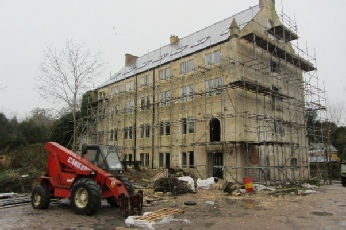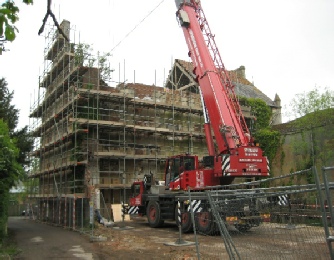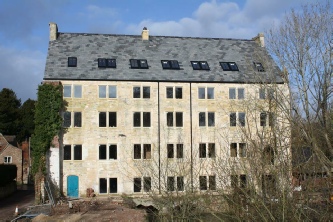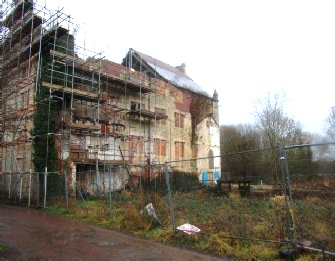

The renovation and conversion of the main mill has finally been completed. It now houses eleven apartments of various sizes and configuration. An open day was held on 28th March for the public and perspective buyers to explore the mill. As can be imagined, the views across the surrounding countryside from the upper floors are quite spectacular.
Apart from the apartments upstairs, the ground floor now comprises a large open lobby space. This contains cast iron pillars that support the upper floors, the new water wheel (described previously in ECN), as well as a display of some belt wheels and drive shafting salvaged during the renovation. This will be joined shortly by a large framed display panel outlining the mill’s long history; its period of neglect and decay, and finally, the conversion to residential use.
As well as historical facts about the mill (see below), the panel is illustrated with a number of historical photographs (these are few and far between!), a copy of the local tythe map of 1839 showing the mill’s location and its relationship to the village’s two other cloth mills, plus a plan showing the original layout of the mill when first constructed. There is also a drawing of the steam engine installed in 1821.


Millend Mill -
To briefly recap on the main points in the mill’s history -
During the Middle Ages, the region’s ample water power began to attract the woollen cloth industry to the Stroud valleys. Like many others, Millend Mill switched from corn milling to cloth manufacture.
In 1806, it was bought by Henry Hicks, wealthy landowner and Lord of the Manor of Eastington. He completely rebuilt the mill, completing it in 1818. Cloth manufacture became increasingly mechanised, so more power was needed. Initially, this was provided by three large water wheels driven by an arm of the River Frome. However, power requirements continued to increase and in 1821, a steam engine was installed, one of the first in the area.
By the 1830s, Millend was being run by Charles Hooper. To meet the growing competition and difficult trading condition, he combined operations at Millend with four other local cloth mills. But, by 1869, cloth making at Millend had come to end.



Further information on the mill’s history can be found on the website of the Gloucestershire Society for Industrial Archaeology (GSIA) at: www.gsia.org.uk/
Nearing completion, 2015
Deconstruction under way


Today (back view)
Stephen Mills
Published in ECN 151 Jun/Jul 2015
Millend Mill nearing completion
-
In the 1870s, the mill was converted for flour milling and saw milling.
In 1908, Millend saw another change of use, being converted to a maltings -
In the following years, Millend had a succession of uses that included corn milling and grain drying.
Finally, in the 1960s, it was taken over by an antiques exporting company.
By the 1980s, the mill was effectively abandoned by its owners and began to decay badly.
In 2008, the derelict mill was bought by the present owner. This signalled the start of an extensive programme of restoration and rebuilding that saw it converted from industrial to residential use, the only realistic option. More than £2 million was invested in the mill’s regeneration. And so begins a new chapter in Millend Mill’s long and interesting life.
Millend Mill restoration

